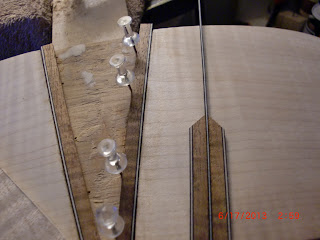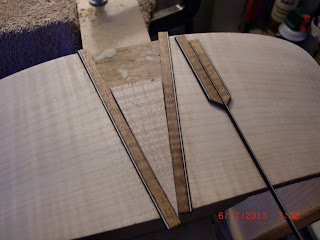 |
| Removing wood from heel graft area |
Heel grafts are so important to the overall scheme in the guitar, because this specific guitar is colonial themed, I will be applying a one of a kind arrow style inlay to hearken back to the period. In the above picture you can see I have laid out my shapes and am in the process of removing the curly maple down to the bare mahogany tail block. Good quality sharp tools make this job a pleasure to do, without them I may as well set everything aside and go into the back yard and find a tail to chase. Because I use so many hand tools in my lutherie process, I am aware at all times of the need to keep my tools sharp and ready for work. A good set of chisels and a Japanese style back cut saw are the main tools used in this process, that and some imagination and your hands which are your most important tools of all and come with no warranty or replacement program.
 |
| Cutting and fitting inlay |
 |
| Arrow shaft design taking shape |
I will have to split the maple arrow head right down the center to accept the purfling running from the arrow shaft inlay. There will also be purfling running across the bevel seen at the end of the shaft. This is extremely detail oriented work and one of my favorite parts of building guitars. Inlays, rosettes, bindings, all things which can become a luthiers signature touch upon his work and are some of the more artistic aspects of lutherie.
 |
| beginning the fit of the arrow head and shaft |
 |
| Marking out the cuts |
Once all of the cuts are marked I pull it all back apart and make my cuts and refit several times until everything lines up perfectly. I use a lot of thick CA glue when applying the inlays and thin CA glue to weep in from above after sections have been glued in. I love watching these grafts take shape, there is never a dull moment.
 |
| Preparing the ebony |
Because I exclusively use real wood in every aspect of the guitar, aside from carbon fiber in a few key places, often I must cut thin slices from large chunks of the wood I wish to work with. Ebony is a fairly hard wood and it works good, but it can cause a person some grief especially when working in thinly sliced pieces for inlay work. I will cut the slices from this section of ebony pictured above with my backsaw. The pieces will fill the voids on either side of the arrow shaft and add a striking juxtaposition to the surrounding woods. In a way it will also organically tie in the ebony bridge and fret board to the grafted end cap area.
Unfortunately life calls me away for the day so stay tuned to see the heel graft inlay completed and the binding applied to the cutaway and neck block areas.
No comments:
Post a Comment